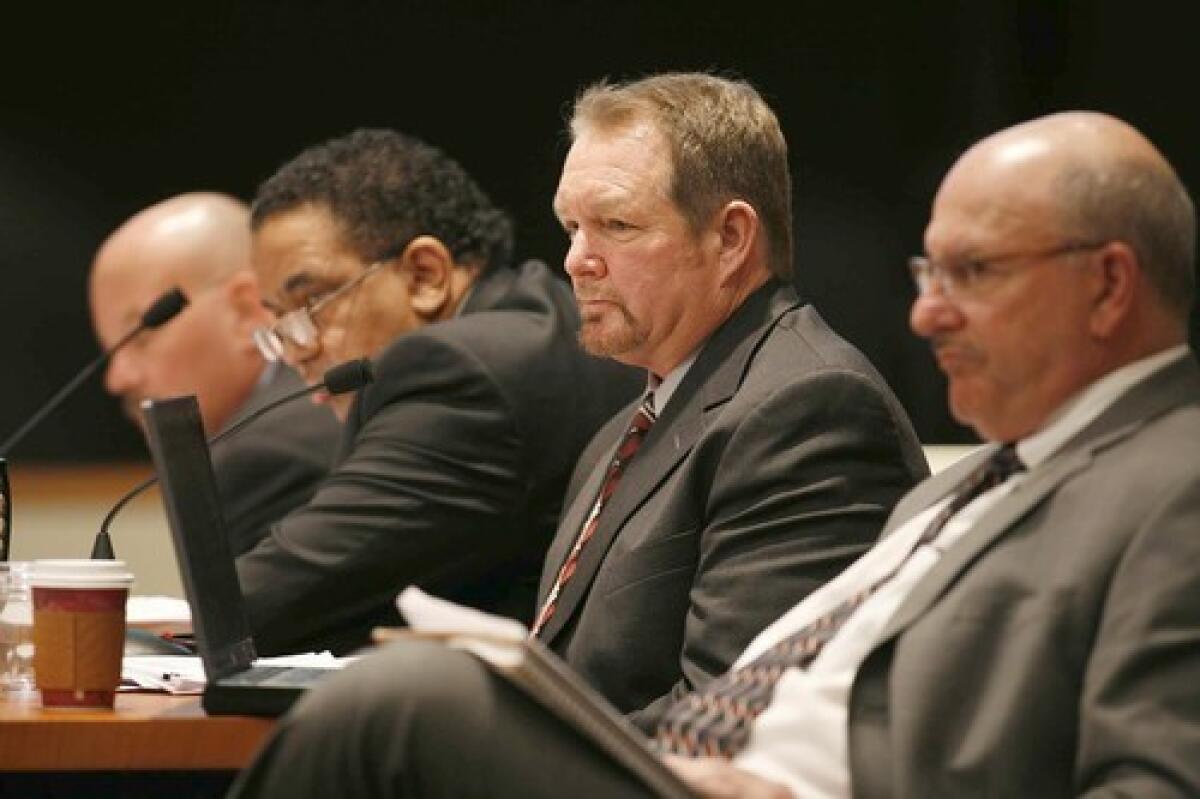Metrolink engineer let unauthorized ‘rail enthusiasts’ control train

- Share via
Reporting from Los Angeles and Washington — The Metrolink engineer involved in a deadly rail disaster in Chatsworth last fall not only allowed unauthorized rail enthusiasts to sometimes ride in his cab, but on at least one occasion let a teen take the controls. And he planned to do it again on the day of the crash, records show.
The conduct, a serious violation of safety regulations, was disclosed Tuesday in a series of cellphone text messages presented as evidence in a National Transportation Safety Board hearing on the collision.
As the hearing progressed, NTSB investigators grilled railroad officials about what they did to detect and stop the engineer’s dangerous conduct and raised questions about whether the cluster of apparent violations of safety rules was an isolated case. “I frankly find that hard to believe,” said NTSB member Kathryn O’Leary Higgins, who is chairing the two-day inquiry in Washington, D.C.
Two days before the crash, engineer Robert M. Sanchez exchanged e-mails with the “rail enthusiasts” -- teenagers, according to sources -- discussing a ride-along that apparently took place the night before. The messages indicate one of the riders was “up in the cab” and “touching the controls.” Sanchez commented on how much one enthusiast “wanted to stay in the seat.”
Sanchez sent a text message that day arranging another ride-along with one of the unidentified rail buffs, saying, “this time I’m taking a picture of you @ da throttle!!!”
Messaging another prospective rider about a trip planned for the evening of the Sept. 12 crash, Sanchez wrote: “yea . . . but I’m REALLY looking forward to getting you in the cab and showing you how to run a locomotive.”
That recipient, also unidentified, responded: “Omg [oh my God] dude me too. Running a locomotive. Having all of that in the palms of my hands. Its a great feeling. And ill do it so good from all my practice on the simulator.”
Sanchez answered: “I’m gonna do all the radio talkin’ . . . ur gonna run the locomotive & I’m gonna tell u how to do it.”
The Times reported last week that text messages indicated Sanchez had let rail enthusiasts ride in locomotive cabs, but conversation details released Tuesday also show that he tried to cover it up.
“I’m going to have to swear you to secretcy on this. not a word to anyone when we do. sorry but it needs to be that way” Sanchez messaged.
The recipient responded: “My lips are # sealed. Not a word will be spoken. You have my word on it.”
In the Chatsworth crash, Sanchez failed to stop at a red signal and hit a Union Pacific freight train head-on. Along with Sanchez, 24 passengers were killed and 135 injured.
Three days before the crash, officials with Connex Railroad, which supplies Metrolink crews, called Sanchez on the carpet for running a train four minutes late, according to testimony. Although supervisors had warned Sanchez about improper cellphone use on two previous occasions, the topic did not come up during the “counseling” session, testimony shows. Later that evening, officials said, Sanchez allowed another ride-along.
Metrolink officials said they had only one previous report of an unauthorized person in the cab of a train, but that was when Amtrak provided crews. In a statement, Connex said Sanchez’s actions were “repugnant” and “contrary to the most fundamental rules of rail operation.”
“This rogue behavior was uncharacteristic of the Robert Sanchez known to his co-workers, supervisors, friends and neighbors as a dedicated career railroad engineer,” the statement said.
Investigators also found that the conductor on the Union Pacific freight train had used his cellphone 41 times while on duty that day and sent a text message a few minutes before the crash, which he survived along with the rest of that train’s crew. The freight conductor also tested positive for marijuana, records and testimony show.
Higgins expressed alarm at the evidence of serious rules violations. She noted that Sanchez and conductor Robert Heldenbrand were considered valuable, above-average workers by their supervisors. She also noted that Connex reported it had a rigorous testing program.
“I’m having trouble reconciling those two,” Higgins told Connex officials.
Cellphone use by train crews “is a national problem,” Higgins said. “I am looking for strategies for dealing with this. I don’t want to have another 25 people die before we address this problem. This was one day, one train, one crew. It raises for me the question of what the heck else is going on out there?”
Tom McDonald, Connex’s general manager in Los Angeles, said the firm has increased testing of Metrolink employee practices and hired additional supervisors. The company said it performs 1,000 random safety-related tests per month to improve compliance with rules.
But McDonald added, “There is not a lot we can do. We have 145 trains operating a day. If an employee is not cooperating, it is difficult. But we have stepped up our game.”
Rick Dahl, a Connex supervisor, said Sanchez was first warned about violating rail policy in 2006 when inspectors conducted a surprise test and found that his cellphone was turned on inside a personal bag on the train. Another supervisor had called Sanchez’s phone and it rang. “I told the engineer that he was in violation of policy,” Dahl said.
Dahl said he warned Sanchez a second time the month before the crash following a complaint by Heldenbrand, the conductor who often worked with Sanchez. Heldenbrand -- who survived the Chatsworth crash -- had seen the engineer using a cellphone while stopped at a station in August. The conductor told Dahl he had confronted Sanchez, who replied that he was using the phone for “union business.”
“I did an immediate follow-up with the engineer,” Dahl said, adding that he reviewed cellphone policy with Sanchez. Dahl said he did a couple of follow-up observations of Sanchez in the following two weeks and concluded the matter.
But in the two years following the 2006 cellphone violation, Connex officials never did a another surprise test by calling his cellphone while he was in the cab, Dahl acknowledged under questioning.
Tuesday’s testimony also showed that Sanchez had properly called out by radio a yellow flashing signal approaching the crash site. As a safety precaution, engineers are required to radio the color of all signals and conductors are required to confirm any signals requiring the train to slow or prepare to stop.
But there was no evidence the conductor confirmed the warning to prepare to stop as required, according to federal officials. There also is no documentation showing the crew confirmed a second solid yellow signal, indicating the next light may be red, officials said.
Heldenbrand told investigators that he and Sanchez radioed each other that the final light was green, not red. There is no record of that exchange either.
In the previous two and half years, Sanchez was tested many times and his signal calling was designated “above average” and he was considered a “valuable employee,” Dahl said. He added that the engineer did fail signal-announcing tests twice, but suggested that was a low rate.
Heldenbrand “had never failed a test” in the previous two and half years, Dahl said. NTSB investigators ordered that those testing records be produced.
Federal investigators and Metrolink officials said the trackside signal system was working properly before the accident occurred. Sanchez had plenty of time to respond to what tests show was a red light directing him to stop and wait for the Union Pacific freight train to pass, Metrolink officials testified.
The status of the signal has been a point of dispute.
The Times has reported that four witnesses, including Heldenbrand, said the final signal appeared green. But Higgins said evidence gathered by NTSB investigators showed the signal was red.
During questioning, Higgins tried to reconcile the differences between the signal tests and the witnesses’ statements. “We have a conflict here,” she told the two officials representing Metrolink. “Signals are critical to what happened in this accident.”
She noted that Sanchez left the Chatsworth station, accelerating to a speed that would be consistent with a green light.
In addition to whether the last signal was green or red, there has also been some dispute as to whether that signal is visible from the Chatsworth station platform.
Dahl said a test after the crash showed that a green light was visible from the locomotive and the platform. But Higgins said that when she stood on the station platform during the accident investigation, she couldn’t see the signal, which is a mile up the track. Federal investigators reported that the red light could not be seen clearly until the Metrolink train moved 950 feet closer to the signal from the station.
Metrolink’s Howard E. Cox said he had never received complaints from engineers about the visibility of the signal north of the Chatsworth depot.
Times staff writer Dan Weikel contributed to this report.
More to Read
Sign up for Essential California
The most important California stories and recommendations in your inbox every morning.
You may occasionally receive promotional content from the Los Angeles Times.














